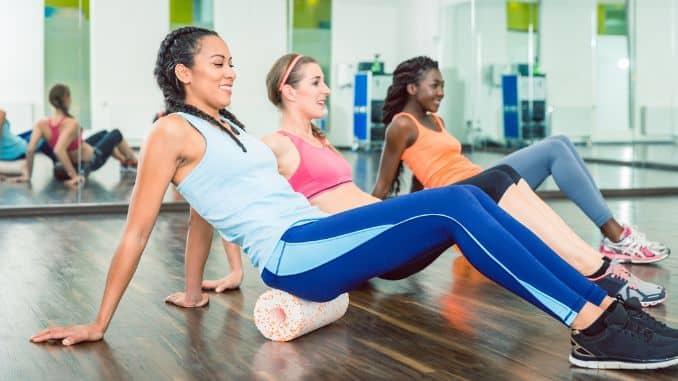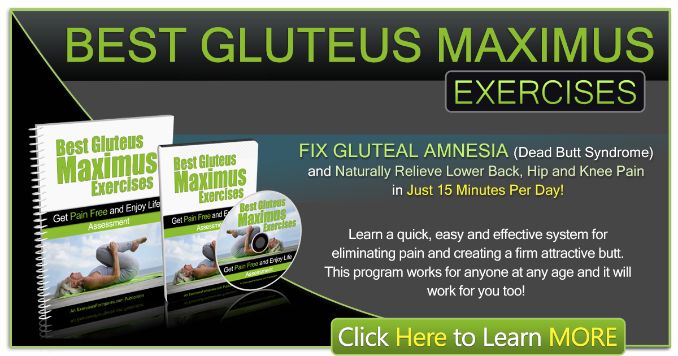If you’re struggling with hip pain [1], tight hip flexors, or limited mobility, you’re not alone. Whether you’re an athlete, spend long hours sitting, or just want to improve flexibility, the right hip massage tool can make a world of difference. The best part? It takes just a few minutes a day to release muscle tension, improve movement, and relieve pain.
Dr. George Cyril, MD (HSS) – He suggests that for milder hip pain, trying at-home treatments first can be beneficial. This includes resting, avoiding activities that aggravate the hip, and applying ice or heat to the area. He emphasizes the importance of not applying ice directly to the skin and using it for 20 minutes at a time.
How to Use a Hip Massage Tool for Maximum Pain Relief?
Before we dive into the best massager for hip pain, here’s a quick rundown of step-by-step exercises you can do with these tools to release tight muscles and ease discomfort.
1. Foam Roller Techniques
A. IT Band Roll (Easy)

- Begin in an upright sitting position on a foam roller with your legs straight.
- Place your hands at the back with your palm pressed on the floor for support.
- Rotate to your right side to place the foam roller under the right side of your IT band area.
- Press your left hand in front of your upper body as you cross one foot over your extended leg.
- Engage your core. Slowly roll from above the knee to your upper hip area.
- Repeat the movement with 10 repetitions. Relax and repeat the movement on the opposite side.
B. Quad Roll
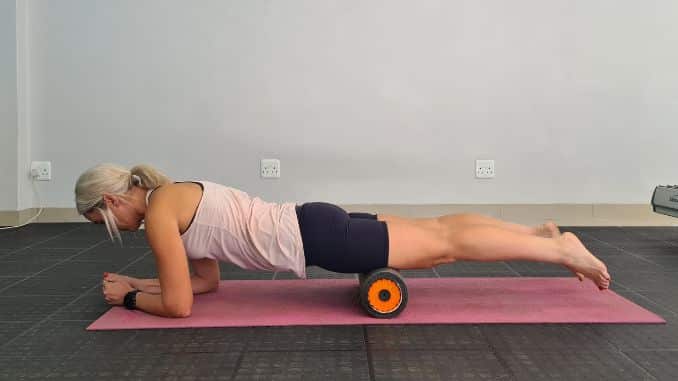
- Begin in a forearm plank position on the floor with your arms beneath your shoulders and your legs straight.
- Place a foam roller underneath your quads.
- Maintain good alignment with your head, shoulders, hips, and toes.
- Tighten your abdominal muscles. S
- lowly roll from the top of your knees up to your hip area.
- Repeat the movement 10 repetitions.
C. Glute Roll
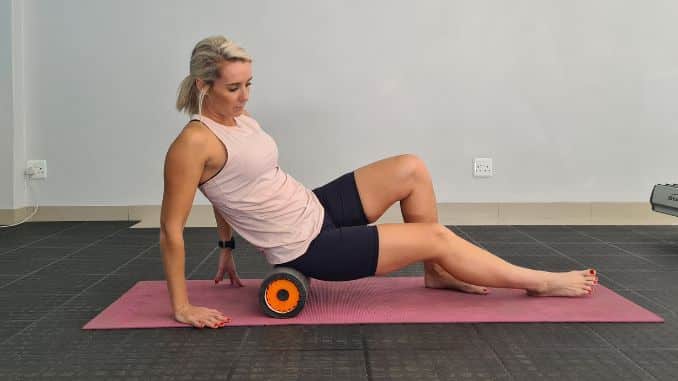
- Begin in an upright sitting position on a foam roller with your knees bent and feet flat on the floor.
- Maintain good alignment with your head, shoulders, and hips.
- Place your hands on your side with palms pressed on the floor for support.
- Lean back slightly and shift your weight to one side, extending one leg while keeping the opposite leg bent.
- Engage your core. Roll from the bottom of your glute to the top of your pelvis.
- Repeat the movement with 10 repetitions.
- Relax and repeat the movement on the opposite side.
2. Massage Stick Techniques
Sticking The Quad
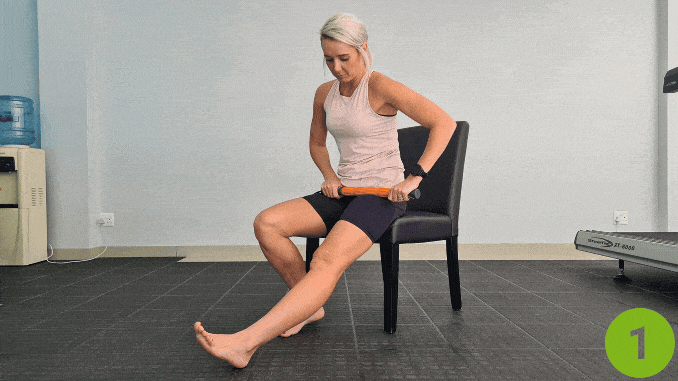
- Begin in an upright sitting position on a chair with your feet flat on the floor, maintaining good alignment with your head, shoulders, and hips.
- Straighten one leg out and place the massage stick against your quadriceps area.
- Run the massage stick from below your hip joint to the top of your knee.
- Depending on your comfort level, repeat the movement on the opposite leg.
3. Massage Ball Techniques
A. Glute Roll
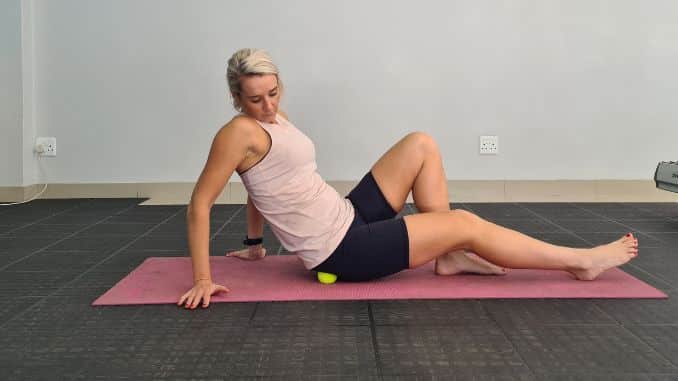
- Begin in an upright sitting position on the floor, your knees bent and feet flat on the floor.
- Maintain good alignment with your head, shoulders, and hips.
- Place your hands on your side with your palms pressed on the floor.
- Place a small massage ball or a tennis ball under your glute.
- Straighten one leg and lean back to a 45-degree angle.
- Roll the ball along your muscle tissue. Repeat the movement 10 repetitions.
- Relax and repeat the movement on the opposite side.
B. (Iliotibial) IT Band Roll
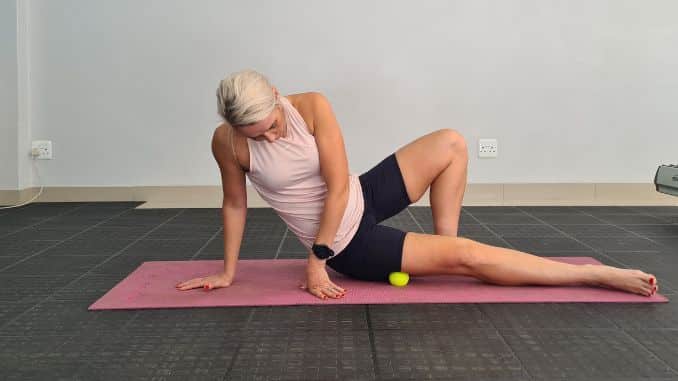
- Begin in an upright sitting position on the floor with your legs straight.
- Bend one knee and rotate your body to the side.
- Press your hands on the floor to support your upper body.
- Place the foam roller under the outer thigh, targeting the tensor fascia lata and lateral quadriceps instead of directly rolling the IT band.
- Slowly roll from the knee to the hip, focusing on the surrounding muscle tissue.
- Repeat the movement 10 repetitions.
- Relax and repeat the movement on the opposite side.
C. Hip Roll
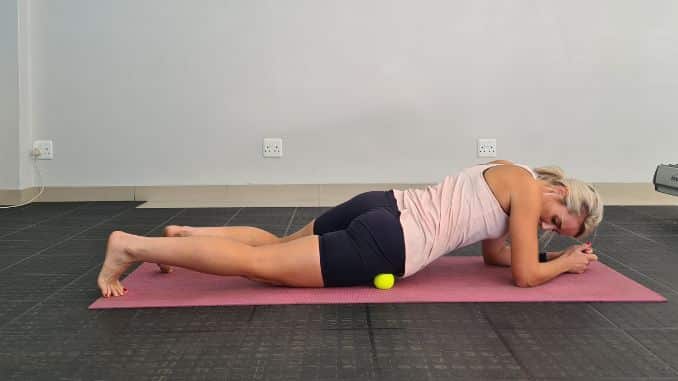
- Begin in a forearm arm plank position with your arms under your shoulders and your legs straight.
- Maintain good alignment with your head, shoulders, hips and toes.
- Place a massage ball or a tennis ball under your hip.
- Engage your core and roll the ball in a circular motion to release deep muscle tension.
- Repeat the movement with 10 repetitions.
- Relax and repeat the movement on the opposite side.
Consult a healthcare professional before starting if you have underlying conditions like osteoporosis, recent injuries, or chronic pain.
Why Hip Massage Tools Work?
Hip massage tools aren’t just about relaxation—they’re about effective pain relief and improved mobility. When you apply pressure to the right spots, these tools help to release muscle tissue, improve circulation, and reduce stiffness in the psoas muscle, iliacus muscles, and hip flexor muscle.
The best massager for hip pain targets key muscle groups, including the psoas, iliacus, glutes, and hip flexors, helping to release tension and improve mobility, specifically designed to ease tightness in the inner thigh, upper back, glutes, hamstrings, and more.
Plus, they’re a great tool for athletes, those recovering from injury, and anyone looking to maintain hip health.
The Best Tools for Hip Pain Relief

- Foam Roller [3] – Ideal for deep hip flexor release, relieving tight muscles, and improving blood circulation.
- Massage Stick – Great for targeting quads, hamstrings, and glutes without needing to lie on the ground.
- Massage Ball – Provides pinpoint pressure for deep tissue release, perfect for psoas, hip flexors, and glutes.
Dr. Kelly Starrett, a physical therapist and mobility expert, recommends using massage tools like foam rollers, lacrosse balls, and massage guns to release tight hip flexors and improve mobility. He emphasizes that direct pressure on the hip flexors (like the psoas and TFL) can help break up adhesions and restore proper movement patterns.
Who Should Use a Hip Massage Tool?
If you experience:
- Hip flexor pain from sitting too much
- Lower back pain due to muscle imbalances
- Tight psoas muscle or iliacus muscles limiting movement
- Pain radiating to the knee, leg, or foot
- Discomfort while standing, walking, or sitting for long periods
Then, incorporating these tools into your routine can help loosen tight muscles, improve movement, and reduce pain naturally.
Final Thoughts
Pain and tightness in the hips can impact your day, making simple movements difficult. But with the right hip flexor release tool, you can roll out tension, loosen muscle tissue, and get the relief you need.
Start slow, apply only with light pressure and shorter sessions (3–5 minutes) that feel comfortable, and be consistent. Whether you use a pso rite, foam roller, or massage ball, these tools can help improve your body’s mobility and help you feel better fast.
Ready to get moving again? Grab a hip massage [2] tool today and give your psoas, glutes, and hip flexors the relief they deserve!
Strengthen your lower body with the Best Gluteus Maximus Exercises for powerful results. Start now and feel the difference!
FAQ’s
What is a hip massage tool?
A hip massage tool is a device designed to release muscle tension, improve blood circulation, and relieve pain in the hip area. Common types include foam rollers, massage balls, and massage sticks.
How does a hip massage tool help with hip pain?
It applies pressure to tight muscles, releasing tension in the psoas, iliacus, and hip flexors, improving mobility and reducing pain.
How often should I use a hip massage tool?
For best results, use 3–5 times weekly for 5–10 minutes. Adjust based on comfort and relief.
Which is the best massager for hip pain?
Foam rollers work well for general relief, while massage balls target deep tissue knots, and massage sticks help with on-the-go muscle tension relief.
Can a hip massage tool help with sciatica or lower back pain?
Yes! A hip massage tool can loosen tight hip flexors and glutes, which often contribute to sciatica and lower back pain by reducing nerve compression.

